how to design a unique meeting room for creative meetings?
1. Introduction

Designing our unique creative meeting room is a great example of in the box thinking. From an urban development perspective, we were literally confined to the 2 existing buildings – not larger, no difference in overall shape or size. These formed our box.
As we’re situated in the middle of a protected village view, next to a historical church and chapel, we were also restricted in the overall look and feel of the building. This allowed us to start playing with contrasts to create a memorable experience for our guests. Our unique meeting space combines a more rural, rustic exterior with an industrial blank slate interior.
The design of our space started with seeking inspiration. Inspiration from scientific studies, books, in-depth interviews with potential users of the space and visits to similar spaces with brainstorming rooms and meeting room rentals. All this information was sorted, assembled and presented to our architect.
In essence, our unique creative meeting room is built along 5 key-elements that trigger creativity in a room: views of nature, space, inspiration, sensory complexity and flexibility.
2. Views of nature
2.1 Importance of nature
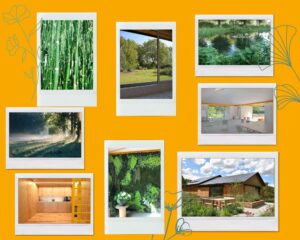
We are moved by nature. Whether it is an environmental disaster like an oil-spill, views of animals brought to slaughterhouses or the destruction of the rain forest. In times of uncertainty, we all return to nature.
When suffering from a clinical depression, one of the therapies that could be suggested is to take a walk, outside, in nature, every day. Many studies have been conducted, all describing the beneficial effects of nature on humans. Both having views of nature (even with paintings or prints) and being in nature. Studies ranging from recovery rates in hospitals to needing less pain medication. Studies on focus with children / students – with or without AD(H)D. In all these cases, nature had healing effects.
Several other studies describe the beneficial effect of walking in nature on creativity. Especially the divergent phase in the creative process benefits from walking in nature. We refer to the quote of Friederich Nietzsche:” All truly great thoughts are conceived by walking”.
2.2 Nature as a Restorative Environment
When it comes to the effect nature has on our mind, we refer to the concept of nature as a Restorative Environment. A concept studied and introduced by Kaplan & Kaplan in 1989 in their book “The Experience of Nature – A Psychological Perspective”. The study deals with the concept of mental fatigue, a state of mind where people are so mentally fatigued that they can hardly function. The struggle to pay attention in a cluttered and confusing environment turns out to be one of the central causes of mental fatigue. Enters the restorative environment to provide rest and recovery. Nature is regarded as one of the most suited environments for recovery because:
- It is considered aesthetically pleasing to the eye
- Natural settings support human functioning
- It fosters the recovery from mental fatigue.
Restorative environments have 4 functions:
- They clear the head of residual clutter – which can be in the way of understanding new task’s requirements and constraints.
- Permit the recovery of directed attention – helping to overcome mental fatigue.
- The soft fascination offered by nature fosters cognitive quiet, mutters the internal noise in our head. It offers effortless interest.
- It offers an opportunity to reflect on one’s life, on one’s priorities and possibilities, on one’s actions and goals. In short: it offers the space of mind to reflect on whether the goal you’re trying to achieve is of importance to you.
Several studies have confirmed this conclusion. The effect is actually twofold: it’s both the removing of the negative influence of technology, as creativity requires us to think for ourselves. It is also adding the benefit of activation the brain systems needed to aid divergent thinking.
Why is this such an important concept? A stressed mind, full of noise is not a creative mind.
3. Space
New research has emerged that could shed a light on the main aspects of a space that influence creativity.
3.1 The height of a room’s ceiling

People who are completing a task in a room with high ceilings, come up with more abstract ideas; while people in rooms with a lower ceiling, presented more concrete options. The conclusion of the study states that ceiling height influences the way you process information and that “elevated ceilings make people feel less constrained, encouraging them to think more freely”. This is however not a case against rooms with low ceilings, as they encourage a more detailed outlook. The perfect place to execute those tasks that need to be accurately done. Important sidenote is that it is not a matter of actual height of the ceiling that counts, but how it feels, the perception of the height.
3.2 Views on nature
We have already touched upon the benefits of nature on our cognitive capacities and our ability to focus. So, when not actually being in nature, views of nature are a great alternative.
3.3 Natural light
Daylight is one of the most underestimated beneficial aspects to improving creativity. It is essential in synchronizing our sleep-wake cycle – our circadian rhythm – enabling us to stay alert through the day and benefit from a restorative sleep at night. Research has shown that children in classrooms with little natural daylight, have disrupted levels of cortisol. 20 min of sunshine every morning keeps the coffee away.
Natural light can be substituted in buildings by using blue-light emitting diodes and full-spectrum fluorescent lights.
However, we do need to note here that, in view of promoting creativity, an open and relaxed atmosphere is also important. And contradicts somewhat with a brightly lit room. Dim light helps to loosen up. More on natural light when we elaborate on the sensory aspects of a creative space.
3.4 Curved edges
Another interesting study revealed that we have a natural preference for objects with curved or rounded edges; versus sharp and squared-off dimensions. Early conclusions are that we prefer the softer edges as we associate sharp angels with danger.
3.5 Seating arrangement
Even the seating arrangement can stimulate creative thinking. Studies have shown that in classrooms where students were seated in a semi-circle versus rows of desks, in the first case student participation was boosted. In the latter case, students worked more independently, and classroom behaviour improved. So again, different configurations can lead to different types of behaviour. We need to be conscious on what type of behaviour we want to stimulate.
3.6 Complexity of the unique creative meeting room
Research also revealed that a room with a higher complexity (both spatially & ornamentally) is associated with more perceived creative potential. Additionally, visually interesting spaces significantly enhanced the perceived creative potential. However, manufactured or unnatural materials had a strong negative correlation. Natural materials had a positive correlation. The texture of wood for example is considered as positively associated. And view and natural view correlated strongly with creative potential. In short: provide visual and tactile stimuli.
Relating to colours, research is inconclusive. Results vary from ‘preference to warm colours’ to ‘it is a matter of what we are accustomed to’.
3.7 Private space for trust
The need for privacy: one of the main rules of brainstorming is: no judgement! We need those bold, over the top ideas! A safe space – both literally and figuratively – is essential.
4. Inspiration
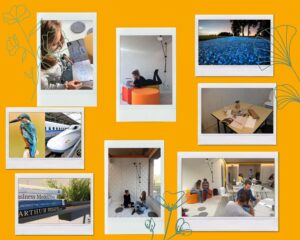
The next important aspect of triggering the mind to come up with new ideas is inspiration. Basically, the mind needs that little spark, a fire starter to form unexpected connections from all that is stored in your mind.
Inspiration comes in many forms, shapes and sizes. Steven Johnson describes in his book “Where good ideas come from”, the perfect mix of ingredients for a good idea. Combine some inherited ideas, add spare parts and old waste, even add in some of the rubbish ideas and mix this with a dash of old traditions. Shake, shake, shake and hey presto: a new good idea immerses. This recipe makes perfect sense taken into account his premise that new possibilities arise in the adjacent possible of what already exists. Evolution is the continuous exploration of the boundaries of what already exists. Each new innovative idea will open up an entire new pathway to explore.
He also emphasised the importance of liquid networks and what he called “the slow hunch”. As he states: “most new ideas are half-baked, a great start but not yet there. They need to connect with other hunches, other ideas, so they can be combined into a great idea.” These connections either happen by going for a walk, absorbing new ideas (reading a book, browsing the internet) or building on other people’s knowledge by sharing and discussing hunches.
We also refer to the quote we already mentioned earlier from Carl Jung: “the creative mind plays with the object it loves”. Looking at an object or issue from all angles, might just give rise to the perfect hunch that could lead to a solution of your quest.
5. Sensory complexity
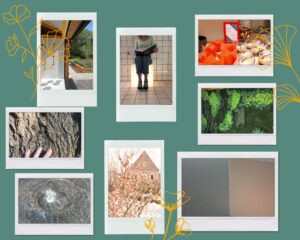
The senses play an important part when designing a space to influence the mind. Because, after all, we perceive our environment through seeing, hearing, smelling, touching and tasting. As a complex human being, we thrive in balanced conditions where all our senses are addressed.
Why is rich architecture so important? Our mind is very much like a toddler. When you introduce a new toy, he is over the moon and will obsessively stay focused on the one toy. However, boredom very quickly sets in, because novelty tends to wear of rather quickly. So, when we are faced with the same bland environment over and over again, where nothing changes, our mind shuts down. We lose the ability of creative thinking. We need the perceptual richness to form new or strengthen existing neural circuits in our brain.
Additionally, a creative mind is also a perceptive mind. When days start to feel like a never-ending, bland, dull and full of more of the same, we can fire up our days by focusing more on our senses. Because our senses bring us in contact with the world around us, we notice more, we appreciate more, we live more.
So, aside from a visually pleasing space, how can we speak to our other senses?
5.1 The significance of the Shadow
We already touched upon the importance of natural light and the effect it has on our circadian rhythm. A lack of natural light can not only lead to a lack of focus and raised cortisol levels, but also – for those that are susceptible – anxiety, (seasonal) depression and fatigue.
One would say: a building made of glass must be bright enough? Imagination and daydreaming, 2 activities that are essential to creative thinking, need besides light, also shadow and darkness. When everything is bright and clear in your face, there is no room for imagination, for dreaming of alternatives. Soft, naturals lights with hints of shadow and unlit surfaces provide a dreamy atmosphere, perfect for brainstorming.
5.2 Acoustic Intimacy
Our hearing anchors us in the world. From the moment we are born, our hearing tells us what is happening around us. We can detect and identify a vast range of sounds, pinpoint the location from where a sound comes from, and whether it is a friendly sound or a threat. As humans, we also have an interesting tendency to prioritise human voices over background noise.
Too much or too little sound can also have a direct impact on the mind. High level of noise can lead to increased blood pressure, elevated heart rate, stress and anxiety. Too little sound can make your environment feel somewhat sterile.
Music is an obvious place to start. Music plays an important role in activities and rituals in every part of the world. It has an important impact on our bodies. Music not only improves your health, hearing your favourite music can also stimulate the brain. It is actually considered as one of the quickest ways to get a mood boost.
Sound is also a very powerful sense to create either feelings of hospitality or hostility. A cold empty room feels very different than a space that holds a receptive, thoughtful silence. Old buildings or carefully furnished rooms often provide us with the experience of a slow, healing rhythm, in contrast to the crazy, busy world outside. In the most beautiful buildings of the world, time disappears.
Have you ever noticed that, although we often talk about retreating into nature’s silence, nature is actually never silent? But for us humans, we often do not look for complete silence (as that can have a creepy feel to it); we look for human silence. Something that you can find in our garden, whenever needed.
5.3 Spaces of scent
The sense of smell is one of the least understood senses and of one the most complex. A specific scent can evoke a whole arsenal of memories, long forgotten and highly personal. We could say that the nose makes the eyes remember. And memory and imagination often go hand in hand. A comforting and stimulating smell for one can provoke tension or a panic attack for another. Add to that, that it is very difficult to turn off a smell. It lingers in the air.
In our modern world, smell is considered as something very personal and even invasive. Living in our modern cities, we have become almost terrified of natural smells, making our buildings and cities a single, bland, globalised, sanitised space of nothingness. Even the mouldy smell in old buildings tells a story…
5.4 The shape of touch
While seeing is believing, to touch feels like an encounter with reality. The sense of touch is an essential part of the largest organ of the human body: the skin. Again, a sense that we do not fully understand, but vital. The skin will read the texture, weight, substance and temperature of many objects. It will tell us the story of the object and provide us with a new experience. The use of natural materials is actually very linked to the touch, like wood, polished stone, patina on statues or buildings. They not only provide an enriching experience, they also -again- tell a fascinating story. One that plastic objects or glass buildings could never provide.
5.5 The experiment of taste
Our sense of taste seems less important when we discuss the design of a meeting room. But nothing is further from the truth. We have all had the experience of being able to ”taste” a bad smell. The sight or smell of a tasty dish can be mouth-watering. There is also a good reason why McDonalds signature colors are red and yellow. Those colors stimulate hunger, speed and quickness. Basically: in, eat and out again; as quickly as possible. And let’s not forget that babies (and puppies!) use their mouth as primary means of exploring their environment.
As for smell, what we eat, how and with whom are often tightly linked to our memories, culture and heritage. Writer Marcel Proust experienced a flash of past memories while eating a tea-soaked madeleine cookie, now referred to as the “Proust effect”. We’ve also briefly touched upon this effect when discussing the power of scent. But as Proust actually wrote more about taste, it is more at home here.
An interesting parallel can be found between the current emphasis on the perfect image, the perfect flat illustration of what hits our eyes with the evolution of the taste of food. With our ever-busy lives, we often reach for what is ready-made. And the food-industry has succeeded in engineering their products to be irresistible, to hit all the flavor “bliss-points”. Resulting in not only many health issues, but especially a flattening of the taste of our food. We are no longer used to eating naturally sour or bitter tastes and sugar is added to almost everything.
5.6 The image of action
One sense that is not generally considered as a sense, is the image of action. Architecture has an inherent suggestion of action, as it guides the body through the experience. Steppingstones set in the grass are images and imprints of footsteps. As we open a door, the body weight meets the weight of the door; the legs measure the steps as we ascend a stairway, the hand strokes the handrail, and the entire body moves diagonally and dramatically through space.
6. Flexibility
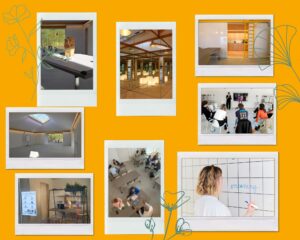
And we have arrived at the last element in a space that stimulates creativity and leads to innovative ideas: flexibility. Because once the mind is exposed to the same space day after day, routine inevitably sets in. No matter how nice that space is. Flexibility in the design of a space is essential to keep the mind active and alert. Artificial grass as flooring was a big hit 10 years ago. Now it’s more business as usual.
We have played with many different ideas when designing our space. In the end, we opted for a timeless design – a blank canvas. All our large items are on wheels and can be placed anywhere ensuring different configurations to match your needs. We have multiple writing surfaces. We created 2 main meeting spaces. Connected to these main meeting rooms, we have created different smaller meeting rooms as break-out rooms. Flexible lighting options allow you to set the light just right.
7. Have we succeeded?
Within the constraints we faced – aka our box – we definitely succeeded in ticking most, if not all of the boxes. From the feedback we received from the many groups we had the pleasure to host, most were impressed with the freshness of the room, having plenty of space, the unique features, the outdoor space making it the ideal location not only for special events but also for team buildings and business meetings. But above all, many described a sense of calm, being at ease, ready for an exciting day of hard work ahead. The right place for a unique experience.
Remember, while seeing is believing, to touch feels like an encounter with reality. We welcome you wholeheartedly into our unique creative space to host your next event or productive meeting.
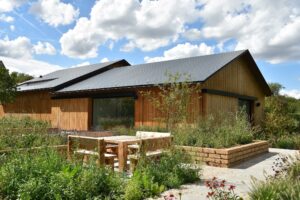
Sign up for our newsletter if you want to stay up-to-date with the ins and outs @ Creative Wonderland!
